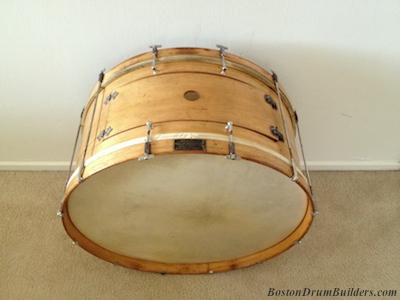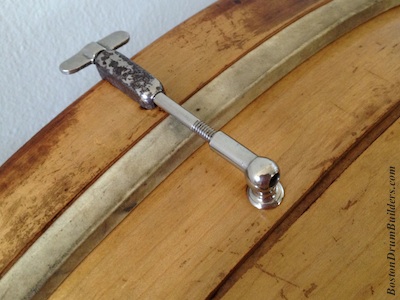There's nothing more annoying than an old drum that shows up missing one small piece of hardware. It's not as if extra parts from small early 20th century drum makers are easy to come by. But when spare parts do come along, I tend to snatch them up whether or not I have a real need for them at the moment. One viable source of spare parts is a so called 'donor drum' - an instrument that in such a sad state of disrepair that it can only be used for extra parts to be be 'donated' to other projects. Such was the case with a George B. Stone & Son Separate Tension Orchestra Drum which came along this past Spring.
Upon arrival it was not a pretty sight. The thin one-ply maple shell was collapsing. The internal reinforcing rings were completely separated from the shell. The original badge and grommet were both missing. And the whole drum - shell, hoops, and even the tension rods - had been painted! No strainer was present and the drum was missing 7 claws and tension rods to boot. Unfortunately, there was no realistic chance of putting this drum back together. But as a donor drum, it was worth bringing in. | |  |
I've had for several years now a late 1910s - early 1920s George B. Stone & Son Separate Tension Band Drum. It was a real train wreck when I bought it back in 2009. Every inch of the drum had been painted and several cracks ran horizontally most of way around the shell. The hardware was mostly intact but a few small pieces were missing. It was going to take a lot of work to bring this one back but it appeared that it was possible. First the shell and hoops were stripped. Then the shell was repaired by a professional. The hardware was cleaned and polished, and the shell and hoops were refinished. New heads were tucked and mounted, and new gut snares were installed. In the end, this one turned out much better than I had expected!
But two small missing pieces remained missing - a single tension rod and claw. Enter the donor drum purchased this Spring.
One rod and claw were removed from the donor drum and then cleaned and polished. We were all set ... sort of. The donor drum was of an earlier generation than the three Stone Separate Tension Drums I already owned including the 8" x 15" Band Drum. That much I knew when I opened up the donor drum and saw the single ply shell with three re-rings. But what I didn't expect was that the tension rods from the earlier drum would not match the ones from the later drum!
It's not a deal breaker fortunately as the differences are mostly cosmetic. The rods are essentially the same length and the thread size matches. The most significant difference is the shape of the head. The rods from the earlier drum are shorter and are nearly flat on top. The later rods have noticeably taller heads and are more rounded over. The good news is that the donor rod fits and that the Separate Tension Band Drum is finally complete, if slightly unoriginal. And at first glance, even I don't notice that one tension rod is a slight mismatch.
As an added plus, we now know that there were at least two different generations of slotted tension rods used by George B. Stone through the 1910s and 20s. And hopefully somewhere down the road we will be able to develop a more detailed dating guide for Stone drums using benchmarks such as this one.
Do you have a drum made by George B. Stone & Son? I want to hear from you! Send Lee an email at
lee@vinson.net.

























